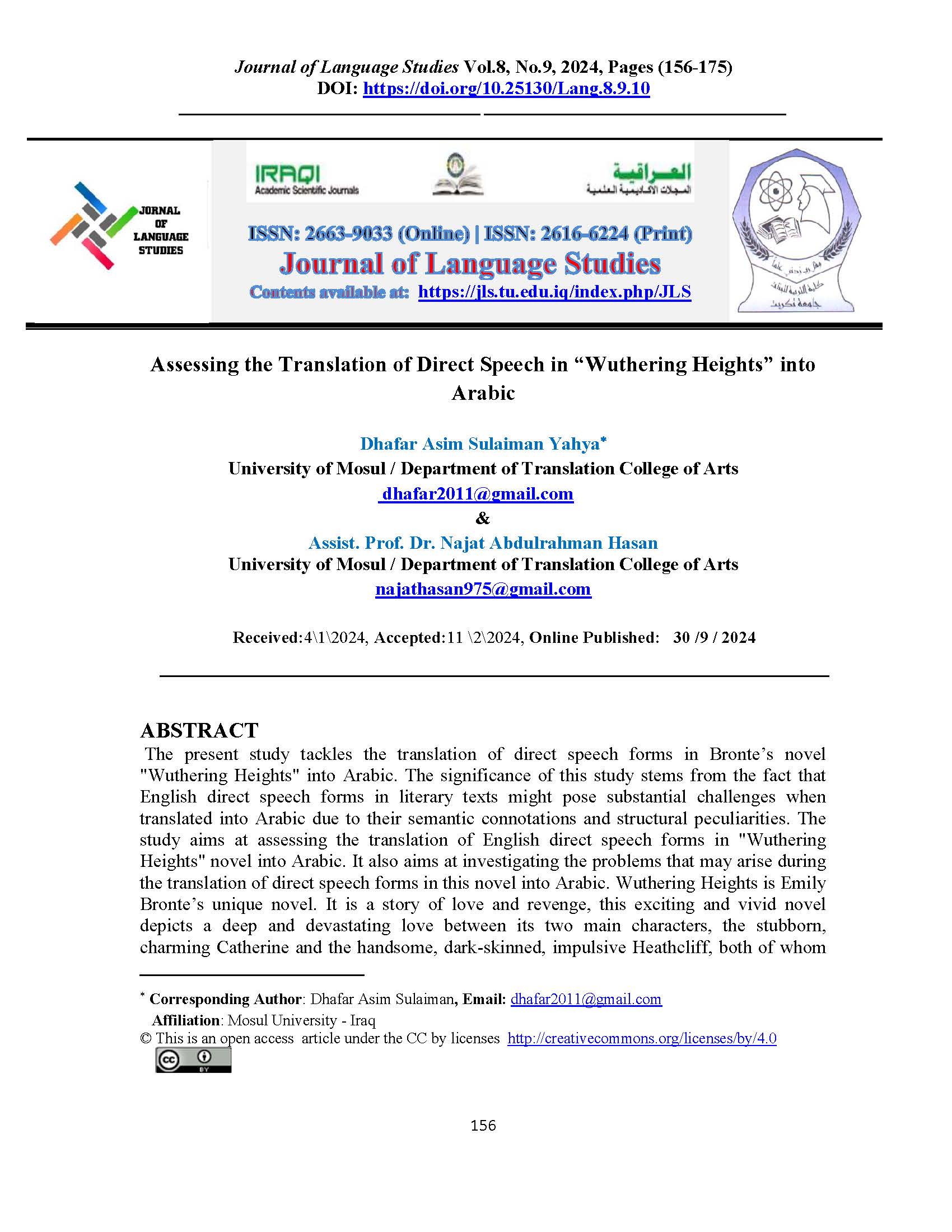Assessing the Translation of Direct Speech in “Wuthering Heights” into Arabic
DOI:
https://doi.org/10.25130/Lang.8.9.10Keywords:
context, direct speech, reporting verbs, translation, literary translation, adaptationAbstract
The present study tackles the translation of direct speech forms in Bronte’s novel "Wuthering Heights" into Arabic. The significance of this study stems from the fact that English direct speech forms in literary texts might pose substantial challenges when translated into Arabic due to their semantic connotations and structural peculiarities. The study aims at assessing the translation of English direct speech forms in "Wuthering Heights" novel into Arabic. It also aims at investigating the problems that may arise during the translation of direct speech forms in this novel into Arabic. Wuthering Heights is Emily Bronte’s unique novel. It is a story of love and revenge, this exciting and vivid novel depicts a deep and devastating love between its two main characters, the stubborn, charming Catherine and the handsome, dark-skinned, impulsive Heathcliff, both of whom are as wild as the Yorkshire moors where the novel takes place The study hypothesizes that translating direct speech in literary texts poses serious difficulties for the translators. To test the validity of the hypothesis, the study includes a practical chapter which tackles the translation of (25) excerpts that have been chosen from Wuthering Heights novel along with four Arabic translation versions. The Arabic renderings are those of the Arabic Cultural Centre (2016), Rifaat Naseem (1975), Helmi Murad (2003) and Hanna Saeed (2021). The analysis is implemented according to the model proposed by Vinay and Darbelnet (1958) which tackles the different kinds of translation approaches and strategies available for the translator when handling the task of translating various kinds of texts.
The study concludes that novice and unskilled translators might encounter serious difficulties and challenges in translating direct speech expressions due to the multiple meanings and connotations inherent in such expressions. It also concludes that context plays a vital role in defining the most appropriate rendering for the SL text.
References
- ENGLISH REFERENCES
Al-Shamary, A. Ahmed. 2001. S. peech Presentation in Virginia Woolf’s and Somerset Maugham’s Short StoriesUniversity of Baghdad.
Berhail Sara. 2016-2017. A Corpus Based Analysis of the Use of Reporting Verbs in Master Dissertations. Larbi Ben M’hidi University_Oum El Bouaghi, Department of English, Algeria.
Blackstone, B. (1962). Indirect Speech: its principle and practice. (No Title).
Bloch, J. (2010). A concordance_ based study of the use of reporting verbs as rhetorical devices in academic papers. Journal of Writing Research.
Carter R. and McCarthy M. 2006. Cambridge Grammar of English. Cambridge University Press.
Chaibeddra, S. and Labed N. 2017/8/22. On Realising the Expressive Speech Act Through the use of Exclamatory Sentences in Written Discourse. Department de Lettres et Langue Anglaise, Universite Des Freres Mentouri, Constantine (Algerie) No.11,Volume 03.
Coulmas Florian, 1986. Direct and Indirect Speech. Monton de Gruyter (formerly Mouton, The Hague) is a Division of Walter de Gruyter & Co. Berlin.
DeCapua Andrea. 2008. Grammar for Teacher. Springer Science + Business Media, LLC. New York.
Downing, A. and Locke P. (2002). A University course in English grammar. Psychology Press.
Guldemann, T. 2012. Thetic speaker-instantiating quotative indexes as a cross-linguistic type. Publisher: Amsterdam.
Haegeman, L. Wekken, H. 1993. A Modern Course in English Syntax, Routledge.
Herring Peter. 2016. Complete English Grammar Rules. Farlex International.
Khan G., Bolokzy S., Fassberg E. Steven, Rendsburg A. Gary, Rubin D. Aaron, Schwarzwald R. Ora, Zewi Tamar. 2013. Encyclopedia of Hebrew Language and Linguistics. Leiden. Boston.
Michaels A. Laura & Lambrecht K. 1996. The Exclamative Sentence Type in English. University of Colorado, Boulder & University 0f Texas, Austin.
Mikulova J. 2018. Studia Linguistica Masaryk University. Brno
J mikulova@gmail.com
Murphy R. 1994. English Grammar in Use. Printed in Great Britain by Scotprint Ltd, Musselburgh, Scotland.
Myres, J. 1954. The Annual of the British School At Athens. British School at Athens.
Partee, Barbara H. 1973. The Syntax and Semantics of Quotation, in a Festschrift for Morris Halle, ed. by P. Kiparsky and S. Anderson. New York: Holt, 410_18.
Quirk R., Greenbaum S., Leech G., Svartvik J. 1985, A Comprehensive Grammar of English Language. Longman Group UK Limited. England.
Quirk R., Greenbaum S., 1999. A University Grammar of English. Commonwealth Printing Press Ltd. Hong Kong.
Simorangkir I. Malawatry and Passandaran Yosi M. 2, December 2016. The Imperative Sentence in Doloksanggul Toba Batak Language. Journal Pujangga Volume 2.
Trask, R. L. (1993). Language and Linguistics: The key concepts. Taylor & Francis.
Vinay, J. & Darbelnet, J. (1995). Comparative Stylistics of French and English: A Methodology for Translation. Amsterdam/Philadelphia: John Benjamin Publishing Company.
-ARABIC REFERENCES
أطلس النحو العربي. عباس المناصرة مجاز في اللغة العربية وآدابها في جامعة دمشق 1975. الطبعة السادسة_ دار المأمون 2020.
الراجحي، عبده، التطبيق النحوي، دار النهضة العربية، بيروت، 1972.
معاني النحو. الدكتور فاضل صالح السامرائي. 142oهـ_2000م. دار الفكر للطباعة والنشر.

